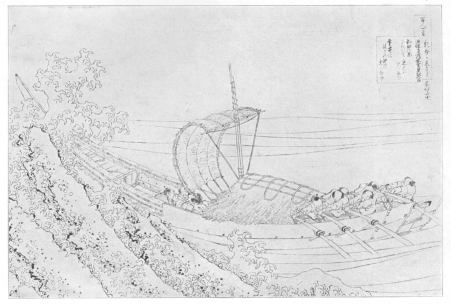Return to the Table of Contents
/ About this book
Tools and Materials Illustrating the
Japanese Method of Colour-Printing
Edward F. Strange
THE DRAWING

|
|
Plate II
HOKUSAI - Original drawing for one of the series
of prints called 'The 100 Poems Explained by the Nurst'
|
Designs for Japanese colour-prints were made by
artists, who, as a rule, were adherents of the Popular
(Ukiyoye) School
and, socially, of the rank of artisans. The drawing was done with a
brush on very thin Mino or Gampi paper, the colours used being washes of water-colour
worked with rice-paste medium. To correct the design, the portions to
be altered were covered with pieces of paper, on which the revised
drawing was made. The completed design (generally, to begin with, in
black lines only, or with only a little tint as a guide to the
engraver) was then fastened face downwards on the block with rice
starch weakened with water. As much as possible of its upper surface
was rubbed away, some oil being used to make the remainder more
translucent, and thus to enable the engraver more easily to follow
the lines of the drawing.
It is evident that this process resulted in the
destruction of the designs. The Museum, however, has acquired a
number of unused drawings, which fully illustrate this stage; and the
series of blocks exhibited (E. 4136 - 4322 - 1909) have, in several
instances, remains of the paper still adhering to the uncut portions
of their surfaces.
* NOTE - The objects exhibited in
the Museum are labelled to correspond with this consecutive series of
numbers.
|
1. ILLUSTRATION of a colour-print artist making
a design; showing his position when drawing and
method of holding the brush.
A colour-print in the Japanese manner, by Emil
Orlik, of Prague.
E. 796 - 1903
|
|
2. ORIGINAL DRAWING (not engraved) for a
colour-print, showing the Artist's corrections. By
Utagawa Kuniyoshi (A.D. 1797 - 1861).
E. 2250 - 1909
Subject - The celebrated swordsmith Sanjo
Kokagi Munechika forging a blade in the grounds of
the Inari Temple, assisted by a Fox-Spirit in the
form of a woman.
|
|
3. ORIGINAL DRAWING (not engraved) for a 3-sheet
colour-print, showing the Artist's corrections. By
Hiroshige I. (A.D. 1796 - 1858).
E. 2229 - 1910
Subject - Street scene in Akabane, Tokyo.
|
|
4. BRUSHES used by (Japanese) painters of the
Chinese School.
E. 4203 - 4206 - 1911
Founded by Josetsu (2nd half of the 14th
century). The style is still practised.
|
|
5. BRUSHES used by painters of the Tosa School.
E. 4200 - 4202 - 1911
The School (the National School of Japanese
Painting) was first composed of a number of groups,
more or less related, which coalesced under the
name of Tosa in the time of Kasuga Tsunetaka (early
13th century), who seems to have been the first to
use this appellation. The style is still practised.
|
|
6. BRUSHES used by painters of the Sesshiu
School.
E. 4190, 4191 - 1911
Founded by Sesshiu (1420 - 1506), and based on
the methods of the Chinese painters of the Sung
Dynasty (960 - 1280). The style is still practised.
|
|
7. BRUSHES used by painters of the Kano School.
E. 27 - 29 - 1913
Founded by Kano Masanobu (1453 - 1550). The
style is still practised.
|
|
8. BRUSHES used by painters of the Maruyama and
Shijo Schools (Naturalistic).
E. 4192 - 4199 - 1911
Founded by Okyo Maruyama (1733 - 1795); and
Matsumura Goshun (1752 - 1811). The style is still
practised.
|
|
9. BRUSHES common to painters of various
Schools.
E. 4207 - 4212 - 1911
|
|
10. BRUSHES used by painters in lacquer.
E. 4213 - 4232 - 1911
|
|
11. BRUSHES used for writing.
E. 170 - 187 - 1911
|
|
